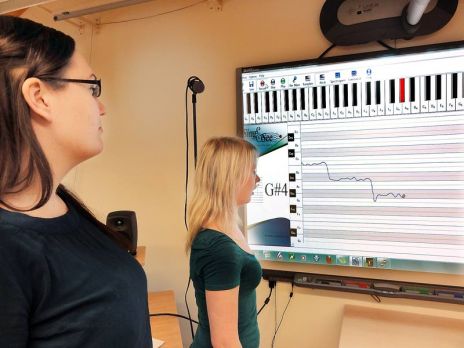I’m 72 and took up singing by joining a local Barbershop Chorus a little over a year ago with no experience or training. (Something to do in retirement!) Being a long time techie guy, I loaded myself down with all the appropriate tech tools I could find in despartion. Sing & See was one of those. Progress has been slow, but they haven’t kicked me out yet, so I guess that means something. Anyway, I have found that Sing & See is the program I use most frequently – usually in conjuction with other programs. It’s the only one I have found that is able to record my efforts visually with any degree of usefulness. It has helped me to at least be acceptible. Pavarotti need not rise from the grave to defend his status, but Tiny Tim definity would. While there are some improvements I would like to see, it is worth the $. I know it seems relatively expensive, but I’m of the old school – you get what you pay for. I have no complaints on that score (pun intended).
By: Bill Nott
Success Stories
Stories from people using Sing & See in their voice training
If you would like to contribute something please add your own story here
[An Indian flute player] Quite an interesting product
I am a classical bansuri (Indian bamboo flute) player from India. I had bought this product couple of years ago after much thought and interaction with William and have been quite happy with its performance. It helps me at least know about the modulation level in my flute and sometimes I also use it for training my vocal cords. I am quite happy to use it and hope the continuous product improvement will increase ones ability to learn music in a much better way. I think it can have applications in speech therapy, leadership training (as voice is an important factor for leaders, watch The King’s Speech). It could help people who have stammering problem and are afraid to speak on the stage. I wish William a great luck and best wishes from the land of The Buddha! I will pray for his success.
Siddhartha Priya, Alumnus – IIT Kharagpur (B. Tech.), IIM Ahmedabad (MBA), ESSEC (France), Solvay (Belgium)
By: Siddhartha Priya
Using Sing&See in Harmonica Playing
Singandsee is not just for singers! It is the perfect for harmonica players as well!
Without getting to involved in the technical aspects of harmonica playing (yes it can be quite technical) most harmonicas are 10 hole diatonic instruments – seven pitches. However, to play Blues requires ‘bending’ (altering the pitch) of notes and, for a beginner, this can be a real challenge but with Singandsee you can practice (and practice and practice) and see when you have it just right – not to mention playing it back and listening to the ‘cool blues’ that you are playing!!!
But wait there’s more; a diatonic harmonica can be played as a chromatic instrument as well (this is very advanced). Chromatic meaning 12 pitches each a semi apart – this requires advanced techniques, and a lots of practice. Once again with the Singandsee you can see the notes on screen and, equally important, use the playback for aural training and confirming when you have the scale and/or song just right.
Glen
Gold Coast
Australia
Using Sing & See to help improve pitching
This is a demo of how I use Sing&See in practice to help me work on a pitch problem.
Here, after a piano cue, I am singing a fifth interval, from A3 to E4 (actually the second two notes in the song “Edelweiss”), and the problem I have is that I sing them flat. To me, at the time, they sound in tune, but if I listen to the audio I don’t like what I hear.
The trace clearly shows that I was singing about a quarter-tone flat. Read the rest of this entry »



